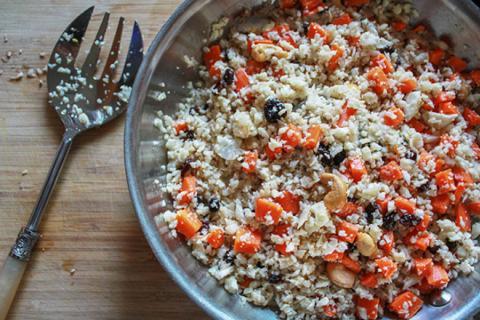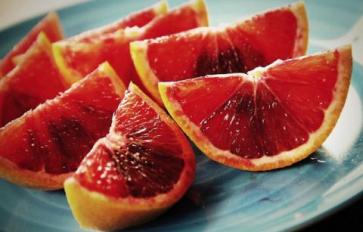
Are you curious about what it means to follow an Ayurvedic diet? Ayurvedic food is about balancing and healing. In practice, eating the Ayurvedic way involves being mindful of seasonality while also considering your body type, or dosha. In this article I’ll show you how this works in real life, with an emphasis on the vata diet; plus I have a yummy recipe for you: cauliflower rice biryani. Let’s get started!
The Vata Balancing Diet
Fall and winter are vata season, which is characterized by cold, light, dry, and rough qualities. As we move through winter, these qualities grow stronger and eventually intermingle with the wet kapha quality that dominates spring. In fall and winter we generally eat to pacify vata. If we have a predominately vata body type, balancing vata during this time of year becomes even more important. Heat helps to balance vata energy: think warm, cooked foods; spicy teas; and soups. Root vegetables also help to ground vata energy.
Biryani, a spiced rice dish, is a traditional Ayurvedic comfort food. Some practitioners suggest eating biryani all year round, adjusting the ingredients according to the season and how balanced your dosha is. My biryani has a rich, earthy, sweet flavor. It’s made up of vegetables and spices that ease digestion and warm and comfort the body, making it perfect for the cold season. In terms of the vata diet, there’s only one seemingly questionable ingredient: cauliflower.
Can I Eat Cauliflower on a Vata Pacifying Diet?
Cauliflower, a cool, sulfurous vegetable, has the potential to aggravate vata. However this isn’t absolute. It depends on other factors like when it’s eaten, how often it’s eaten, the state of your body, and how the cauliflower is prepared. Even if it’s fall or winter and you’re following a vata pacifying diet, you don’t necessarily need to skip cauliflower. Blending it into soup, or cooking it well with spices and oil, as in the recipe below, will mitigate its potentially problematic effect on vata. On the other hand, I don’t suggest eating raw cauliflower on a cold, windy day, or if you’re feeling stressed, especially if you’re vata dominant.
Why Should I Eat Cauliflower Rice?
Regardless of our dosha, many of us don’t do well with rice. Rice contains anti-nutrients that can wreck havoc on the gut wall, and is particularly problematic for people with celiac disease. That’s where cauliflower comes in. When pulverized, cauliflower becomes surprisingly grain-like. As a result, it has become a beloved stand-in for many of us who don’t eat rice for whatever reason. And while I wouldn’t put a piece of sushi atop cauliflower rice, it works well when combined with a number of spices and other vegetables, as in this recipe. Also, once cooked, cauliflower rice keeps well in the refrigerator, which means it’s great for meal planning. The other reason to try this cauliflower rice biryani is that it has a unique earthy/sweet flavor that’s delicious.
Listen To Your Body
The doshas, like the seasons, are dynamic. There aren’t strict lines of demarcation between them; rather, they intermingle. Many of us are bi- or even tri-doshic. Ayurvedic practitioners stress that the doshas describe imbalances and provide insight, but aren’t absolute. When you work with an Ayurvedic practitioner, you receive lists of foods to eat and to avoid based on your dosha. These are guidelines, but the only way to truly know what to eat is to listen to your body. When following an Ayurvedic diet, consider the season and your dosha, how the food is prepared, and also your unique disposition at that time. Eating in this way, over time, most of us begin to fall into the rhythm of nature, gain energy and vibrancy, and just feel well. The earth has this awe-inspiring way of governing the nourishment of our physical bodies, if we let it.
CAULIFLOWER RICE BIRYANI
(GLUTEN-FREE, VEGAN ADAPTABLE, WHOLE 30 FRIENDLY)
Serves: 4
Prep Time: 10 minutes
Cook Time: 20 minutes
Total Time: 30 minutes
Ingredients
- 1 head of cauliflower, washed, leaves trimmed, and cut into florets
- 3 Tablespoons ghee or virgin coconut oil
- 1/2 cup cashews
- 1/4 cup raisins
- 1/4 teaspoon powdered ginger
- 1/4 teaspoon ground fenugreek
- 1/4 teaspoon cinnamon
- pinch of cardamom
- pinch of nutmeg
- 2 carrots, peeled and chopped (medium dice)
- Himalayan salt, to taste
Directions
- Make the cauliflower rice: place the cauliflower florets in a food processor and pulse until they form rice-sized granules, being careful not to over-process. Set aside and proceed with recipe.
- Warm one tablespoon of ghee or coconut oil in a large skillet over medium heat. Add cashews and raisins and cook until the cashews are golden and the raisins are plump and soft. Remove and set aside.
- Add the remaining 2 tablespoons of ghee or coconut oil to the pan. When the ghee or oil is warm, add the spices and sauté for 1 minute. Add the carrots and sauté for about 4 minutes. Stir in the cauliflower rice, sprinkle with salt, and cook, stirring occasionally, for about 6 minutes or until the vegetables are as tender as you like.
- Stir in the sautéed cashews and raisins, allowing all the flavors to marry. Serve immediately or refrigerate for up to three days.
Cooking Notes
- If the cauliflower core is tender, you can use it for the cauliflower rice. If it doesn’t break up proportionately when processed, just pull out the large bits.
- Don’t fill the food processor more than three-quarters full.
- The amount of cauliflower rice used in this recipe is 4 cups.
- Feel free to add other vegetables to your cauliflower rice biryani, like Brussels sprouts and pumpkin, both of which are great for a vata pacifying diet.
Photos by Shiraz Leyva










